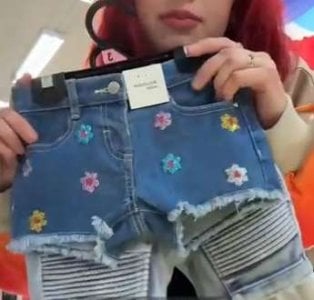Aussie Mum Outraged: Discover What She Unearthed at Kmart That's Causing a Stir
By
Danielle F.
- Replies 8
In a world where we're increasingly aware of the importance of equality and the dangers of early sexualisation, it's disheartening to find that these issues can still rear their heads in the most unexpected places – like the children's clothing aisle of a popular department store. This was the experience of an Australian mum, Althea, whose recent trip to Kmart turned from a routine shopping excursion into a moment of distress and frustration.
Althea's intention was simple: to buy her toddler a pair of shorts. However, what she found upon comparing the boys' and girls' sections was anything but. The disparity in the length of shorts designed for girls versus those for boys was stark and unsettling. The girls' shorts were significantly shorter, more akin to short shorts, while the boys' options were longer, typically reaching around the knee area.
Taking to TikTok to express her dismay, Althea's video quickly went viral, amassing over 600,000 views as she questioned, 'Why are they f**king small?' and lamented, 'I hate this. Why do we make them this short for girls?' Her concerns resonated with many, sparking a conversation about the early sexualisation of girls and the broader implications of gendered clothing.
The issue Althea highlighted is not just about the length of a pair of shorts; it's about the message we're sending to our children. The sexualisation of girls' clothing is a troubling trend that can have far-reaching effects on how young girls perceive themselves and how society perceives them. It's a concern that extends beyond Kmart and into the wider fashion industry, where crop tops and 'cheeky' cut swimwear for young girls are becoming increasingly common.
The response to Althea's TikTok was overwhelming, with many parents sharing their own frustrations and experiences. Some commented on the trend of adding frilly extensions to girls' shorts to make them longer, while others have resorted to buying bike shorts or even boys' shorts for their daughters in search of more appropriate options. The sentiment was clear: parents are struggling to find practical, age-appropriate clothing for their young daughters.
Althea's observations also touched on the gender stereotypes perpetuated by children's clothing designs. She pointed out that girls' clothes often feature hunted animals like unicorns and rabbits, while boys' clothes depict hunters like dinosaurs and lions. This dichotomy reinforces outdated notions of girls and women as helpless and weak, and boys and men as aggressive and strong.
The mum's quest for longer-length shorts for her daughter was about more than just fashion; it was about sun protection and practicality. In the end, she purchased a pair of boys' shorts for her daughter, who was less than thrilled due to her preference for the designs on the girls' shorts.
Kmart has yet to respond to the controversy, but the conversation Althea started is an important one. It's a reminder that as consumers and parents, we have the power to demand change and to choose clothing for our children that aligns with our values. It's also a call to retailers and designers to be more mindful of the messages they're sending through the clothes they create and sell.
At the Seniors Discount Club, we understand the importance of nurturing our grandchildren's self-esteem and ensuring they grow up in a world that values them for who they are, not how they're dressed. We encourage our members to engage in these conversations, to share their experiences, and to support each other in finding solutions that promote the well-being of all children.

What are your thoughts on the gendered differences in children's clothing? Have you faced similar challenges when shopping for your grandchildren? Let's discuss in the comments below and work together to advocate for positive change.
Althea's intention was simple: to buy her toddler a pair of shorts. However, what she found upon comparing the boys' and girls' sections was anything but. The disparity in the length of shorts designed for girls versus those for boys was stark and unsettling. The girls' shorts were significantly shorter, more akin to short shorts, while the boys' options were longer, typically reaching around the knee area.
Taking to TikTok to express her dismay, Althea's video quickly went viral, amassing over 600,000 views as she questioned, 'Why are they f**king small?' and lamented, 'I hate this. Why do we make them this short for girls?' Her concerns resonated with many, sparking a conversation about the early sexualisation of girls and the broader implications of gendered clothing.
The issue Althea highlighted is not just about the length of a pair of shorts; it's about the message we're sending to our children. The sexualisation of girls' clothing is a troubling trend that can have far-reaching effects on how young girls perceive themselves and how society perceives them. It's a concern that extends beyond Kmart and into the wider fashion industry, where crop tops and 'cheeky' cut swimwear for young girls are becoming increasingly common.
The response to Althea's TikTok was overwhelming, with many parents sharing their own frustrations and experiences. Some commented on the trend of adding frilly extensions to girls' shorts to make them longer, while others have resorted to buying bike shorts or even boys' shorts for their daughters in search of more appropriate options. The sentiment was clear: parents are struggling to find practical, age-appropriate clothing for their young daughters.
Althea's observations also touched on the gender stereotypes perpetuated by children's clothing designs. She pointed out that girls' clothes often feature hunted animals like unicorns and rabbits, while boys' clothes depict hunters like dinosaurs and lions. This dichotomy reinforces outdated notions of girls and women as helpless and weak, and boys and men as aggressive and strong.
The mum's quest for longer-length shorts for her daughter was about more than just fashion; it was about sun protection and practicality. In the end, she purchased a pair of boys' shorts for her daughter, who was less than thrilled due to her preference for the designs on the girls' shorts.
Kmart has yet to respond to the controversy, but the conversation Althea started is an important one. It's a reminder that as consumers and parents, we have the power to demand change and to choose clothing for our children that aligns with our values. It's also a call to retailers and designers to be more mindful of the messages they're sending through the clothes they create and sell.
At the Seniors Discount Club, we understand the importance of nurturing our grandchildren's self-esteem and ensuring they grow up in a world that values them for who they are, not how they're dressed. We encourage our members to engage in these conversations, to share their experiences, and to support each other in finding solutions that promote the well-being of all children.
Key Takeaways
- An Aussie mum expressed her frustration and concern over the sexualisation of young girls, illustrated by the significant difference in length between shorts for girls and boys on sale at Kmart.
- The mum’s TikTok video highlighting this issue went viral, gathering over 600,000 views and sparking a broad online discussion regarding children's clothing.
- Comments from the public suggested a trend of discomfort and discontent with the sexualisation of young girls' clothing, and some are taking alternative measures such as adding extensions to the shorts.
- The concerned mum emphasised the deeper societal issues reflected in children’s clothing choices, such as the perpetuation of gender stereotypes and the need for practical clothing options that offer sun protection for kids.








